by tmoffett | Apr 24, 2012 | Color, Composition, Landscape
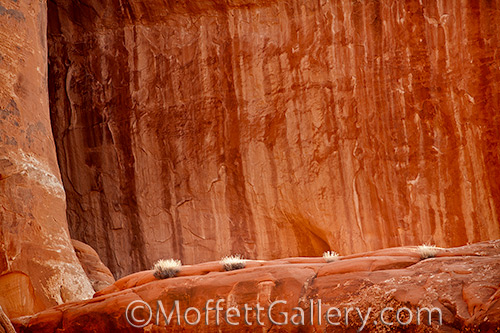
First Light, Arches National Park
One of the hardest principles of good composition to teach is that of simplicity. Elimination of everything in the frame that does not enhance the image creates a composition that will have much more power and impact on the viewer. Slowing down is the key. In today’s world, we are so used to multi-tasking that slowing down and simplifying anything is against our nature, yet doing so, I have found, allows me to enjoy life so much more. I see differently when I take the time. My vision becomes more clear. My photographs become more powerful.
This is an image that I made while at Arches National Park recently. I had hiked in to Landscape Arch in the dark in order to be there for sunrise. As the sky grew lighter, I turned around and this is what I saw. It was not what I had come for, but was a pleasant surprise. These four plants, catching the first rays of morning light as they grew out of solid rock were a better composition and much more powerful and meaningful than the arch I had come to photograph. So many times I have hit my own “Brick Wall” and wanted to give up, but persevering, stretching and growing, I was able to overcome and move forward, much like these plants in this sandstone environment. There are many images in nature that when simplified, can relate to our own lives. Parallel meanings are often hid behind confusion, that when we slow down, become observant and eliminate the excess, we will find. When we do, our art becomes powerful.
by tmoffett | Apr 19, 2012 | Color, Composition, Critique, Landscape, Photographic Philosophy
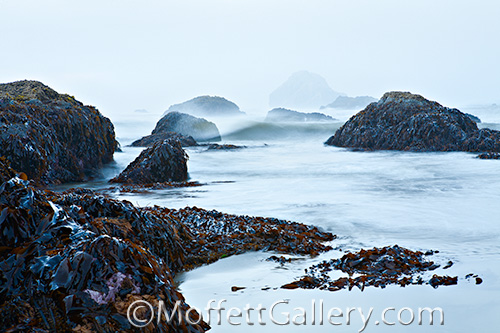
Shoreline at Bandon, Oregon
This happens to be one of my favorite images that I have made along the Oregon Coast. It was a cool, breezy morning and the marine layer was thick, which meant that I would have no dramatic sky. On the coast that is not unusual. I really like what happens here, though. The fog allows for the ocean to appear to vanish into the sky, creating a vastness that otherwise may not be apparent. The thick fog and bluish color of the image helps in creating a coolness, resembling my feelings as I photographed. My images are always about my feelings. It may be what I see, but even more about how I see and what I feel. This particular morning I was cold and wet as I walked the beach in search of an image. I knew, as I walked around the rocks to this location, that I had found what I was looking for. I must have spent 30 minutes or more just watching and dodging the waves as they rushed ashore, finding the correct angle for the composition that said what I wanted and timing the exposure to capture the motion of the water, creating an image resembling the feelings inside of me. When everything comes together as it did here, I am amazed at what can happen.
Photography is really not about the final image, it is about the experience, living the experience and then sharing it through the photographs created.
by tmoffett | Apr 17, 2012 | Color, Family, Landscape
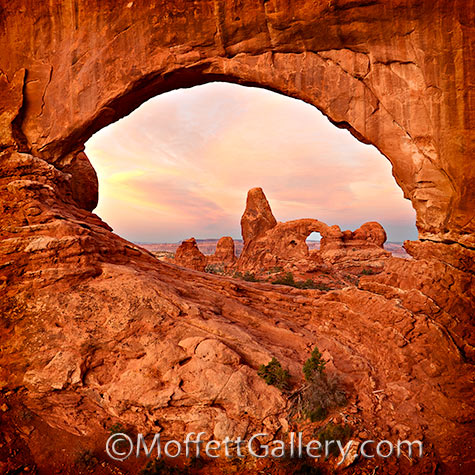
Turret Arch through the North Window
Photography has been a major aspect of my life for a long time. I took photography classes in high school. I studied photography in college, receiving a BFA with a photography emphasis from Utah State University. I have worked as a custom printer, owned my own high end portrait studio for nearly 20 years and now teach photography for a living while pursuing my own fine-art photography passion. As far as a career field, it is all I know.
Arising early in the morning, long before most have even considered rolling out of bed, in order to be at a predetermined location to witness and photograph in the sweet light of sunrise is not a sacrifice for me, it is an opportunity! On my most recent trip to Moab, Utah, it was not uncommon to leave the hotel at 5:00 AM, drive to a destination and hike in the predawn darkness to get where I needed to be for the sunrise. The brisk, early Spring temperatures were quite refreshing. The lack of crowds that fill the parks during the daytime hours was wonderful. Working alone gives plenty of time for reflection and renewal of spirit. On occasion I would meet one or two others searching for the same thing as me. The morning I photographed Turret Arch was one of those occasions. I got a little late of a start that morning, so I was in a hurry to get to the North Window. While carrying nearly 40 pounds of gear, I rushed up the trail, realizing then just how out of shape I was in. I went through the arch and then began to scramble up the rock to a small ledge that allowed me this view of Turret Arch. I was the second photographer in search of that location, and thankfully the one already there was able to direct me to the easiest route up the rock. We shared a very pleasant morning and witnessed a wonderful sunrise. I continued photographing in the area for about an hour, then as the light became harsher I returned to the hotel in time for breakfast with my family.
Following breakfast, I spent the day with my wife and kids enjoying the incredible scenery in the area. We visited the National parks in the area together during the day, hiking in to several arches, picnicking together for lunch and then finding locations to view and photograph the sunset together in the evening. There really is no better life that I could imagine. Family, photography and nature. Life is good!
by tmoffett | Apr 12, 2012 | Color, Landscape, Photographic Philosophy, Photographic Technique, Uncategorized
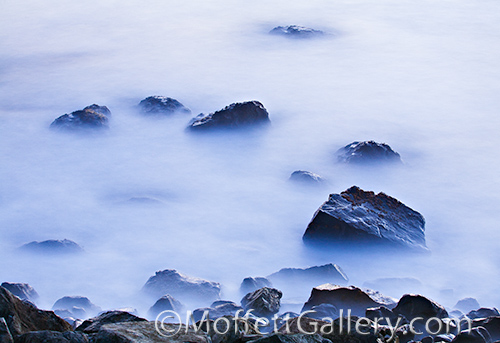
Sea of Mist
I have often said that my favorite time to photograph is just after the sun has set. Well, often I will shoot long after the sun has gone down. This image is one of those times.
It is interesting to me that as many photographers are packing up and going home, I am often just getting started. I like what happens when long exposures capture objects lit with the delicate light coming from the moon. This photograph which is part of my “Shorelines” portfolio, was taken with nearly a 2 minute exposure. The rocks remain tack sharp while the ocean waves crashing ashore become like a sea of mist, soft and delicate. I love how the moisture on the rocks reflects the moonlight and really do look wet, so wet that you can almost feel it when you view the picture. There is also a gentle color shift that I find quite captivating. When I think of the ocean, this is what I see.
If you are a photographer, try not doing a custom white balance sometime. You might just like it! A custom white balance is meant to neutralize the color, making everything look normal, but who is to decide what normal really is. I photograph in this kind of light because of the color, so why would I want to neutralize it? Keeping my white balance in one of the daylight modes will render the colors more closely to how I visualize them instead of removing the color cast caused by the real color of the light that exists, making them appear “normal,” or neutral.
by tmoffett | Apr 10, 2012 | Color, Landscape, Photographic Philosophy, Ramblings
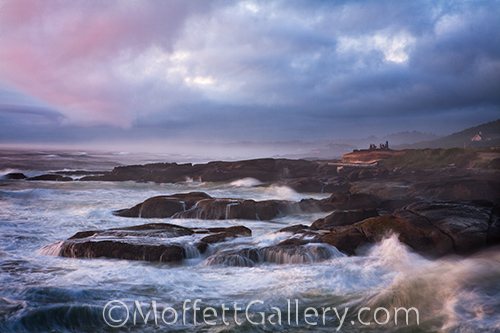
Storm Watchers
Having returned from a Spring Break trip to Moab, Utah, I have settled back in to the routine, sort of. My students are preparing for our big state photography competition that is later this week, my seniors are getting ready for their final show, big projects in my intermediate classes are coming due, personal project deadlines are fast approaching, Spring projects around the house need completed and I am trying to keep my head on straight and not show my stress through it all! This time of year always feels like being on the stormy seas. Then it all will pass and I will begin moving forward again, just in time to have the craziness start all over again. Life seems to get that way frequently for me. Maybe it is just to make me stretch a little. It definitely gets me out of my comfort zone, but always, at least in the past, has been for my good.
I am planning a trip in early May to photograph on the Oregon Coast. The stresses of April will have past and I will be able to find some time for relaxation and regrouping at one of my favorite places on this planet. Even in foul weather on the coast, great photographs await those brave enough to battle the elements. This image attests to that. Enduring the storm and waves, waiting for the perfect clouds, light and waves was a bit miserable, but upon capturing this image, it all became worth it! I have learned that if great effort is made, good things will nearly always be the result. This is not just in photography, but in life itself as well.
by tmoffett | Apr 5, 2012 | Color, Composition, Landscape, Photographic Philosophy, Portraits, Ramblings
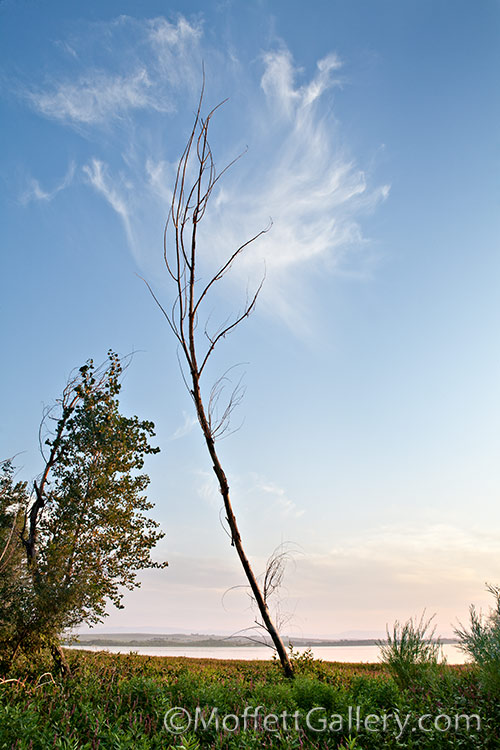
Reaching Upward
While out photographing one evening with a small group of students this image presented itself to me. The students all were hurrying out to the shore of the lake while I took my time observing and enjoying the environment. It was a great teaching moment the next day as I showed the image that everyone had passed up in an effort to get to the final destination. This was my favorite image of the evening. I hope that my students learned something from the experience.
I have learned much from other photographers. Some I have met, others just learned from their photographs. Here a few of my favorite photographers, but by no means is this an all inclusive list. I could list a hundred others who have in some way or another influenced me and my work.
1. Paul Caponigro He will always be on the top of my list. Paul Caponigro is my all time favorite. His images of Stonehenge and other megaliths are very moving. He has a way of really showing emotion in his photographs. I never tire of his photographs.
2. Henri Cartier-Bresson Famed for coining the phrase “The decisive moment.” His simple journalistic style and masterful composition make his images one of a kind. Finding a location and waiting patiently for the right moment to appear in is lens is something that we can all learn from.
3. Yousef Karsh My favorite portrait photographer of all time is Karsh. He had a way of capturing the soul of his subject. This, I believe, can only truly be accomplished by spending time with the subject, which he did. Learning who your subject is and then carefully crafting the portrait with perfect lighting and natural posing are a few of the things that Karsh’s portraits have inspired me to do. A Karsh portrait really communicates.
4. Arnold Newman Another portrait artist whose work has had a great influence on me. He was a master of the environmental portrait with a very simple style.
5. James Nachtwey The importance of being trusted by your subject is evident in his work. His photographs speak for his subjects and can make a difference in the world. Nachtwey brings a very intimate approach to war photography that makes him an advocate for peace.
6. Jay Maisel It’s all about light, shape and color. Find photographs in your everyday world and surroundings. They are there, we just need to find them. That is what Jay Maisel has taught me.
7. Irving Penn I really like his still life images. Simple, yet powerful composition and masterful lighting skills make his photographs some of my favorites.
8. John Sexton His black and white landscape photographs are inspiring. Learning to photograph in the quiet light at the end of the day after the sun has set is something I have learned from the images of John Sexton. Many of his images have a very peaceful, simple look that is very fresh. He is another whose images I never tire of.
My list could go on and on. Everyone has a favorite that could be added, but these are a few of mine. As I look at the work of these eight photographers, the common thread I see that draws me to their work is simplicity. They all have a way of making simple, powerful images. That is something that I have been trying to master for as long as I can remember. The simpler a photograph, the more power that it has. In our complex world, simple is also very refreshing. It is easy to look at. It is peaceful. It communicates. I have learned that by studying the work of other artists and photographers my own work improves. I only wish that I had more time to devote to looking at photographs.








Recent Comments